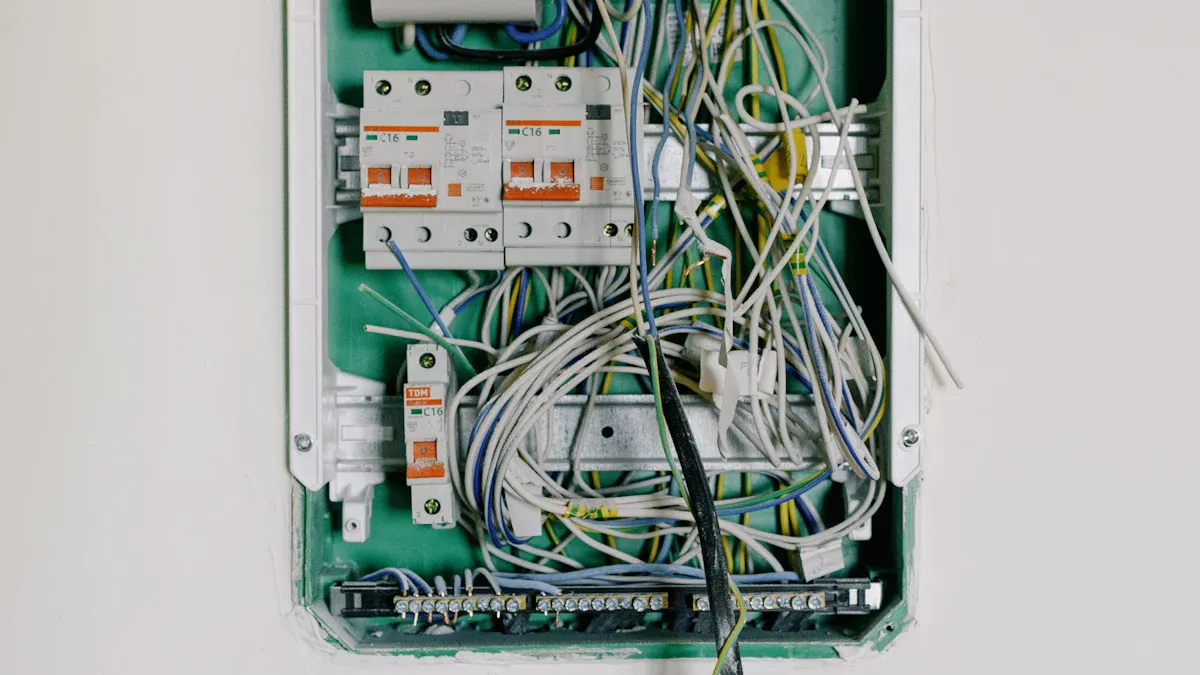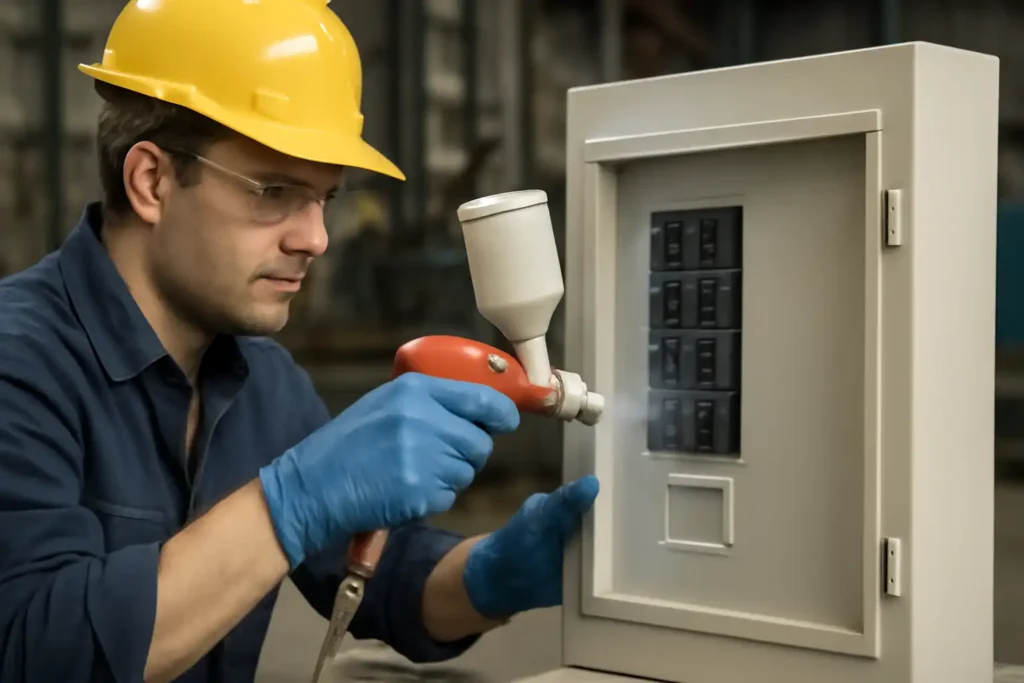Yes, it is safe to engage in circuit breaker box painting, but only if you take the necessary precautions. Make sure to use paint that is non-conductive and can withstand heat. Avoid painting over labels or vents, as neglecting these steps could lead to overheating or pose a danger. Remember, safety should always take precedence over aesthetics.
Key Takeaways
- Always use paint that resists fire and does not conduct electricity.
- Do not cover vents or labels while painting to stay safe and follow rules.
- Use decorative covers or sticky wraps instead of paint for a safer option.
Safety Considerations for Circuit Breaker Box Painting

When painting a circuit breaker box, safety must come first. Here’s how to keep your electrical system safe and working properly.
Fire Safety and Heat Dissipation
Painting the box can be risky if done wrong. Follow these tips:
- Use Fire-Resistant Paint: Pick paint that won’t catch fire and doesn’t conduct electricity. This helps prevent fires caused by heat.
- Allow Heat to Escape: The box gets warm when it’s working. Don’t use thick paint that traps heat, as it can cause overheating.
- Keep Vents Clear: Never paint over vents. These openings help cool the box and stop fire risks.
💡 Tip: Fire-resistant systems can stop up to 80% of electrical fires. Choosing the right paint is very important.
| Evidence Type | Description |
|---|---|
| Fire Prevention Effectiveness | Stops about 80% of electrical fires, lowering risks greatly. |
| False Alarm Rate | Rarely causes false alarms or incorrect warnings. |
| Data Novelty | Uses new data to improve fire safety in homes. |
Compliance with Electrical Codes
Check your local rules before painting. These rules keep your box safe and working well. Remember:
- Don’t Cover Labels: Labels on the box give important information. Painting over them can break rules and create safety problems.
- Protect Components: Some paints can leak inside and harm the parts. This can stop the box from working right.
- Keep It Accessible: Make sure the box can still be opened easily. Quick access is needed during emergencies.
| Key Consideration | Details |
|---|---|
| Required Markings | Don’t hide labels when painting the box cover. |
| Functionality | Be careful with spray paint; it can damage the box inside. |
| Accessibility | Don’t paint in a way that makes opening the box harder. |
| Risks of Spray Paint | Spray paint can harm unsealed areas inside the box. |
⚠️ Note: Breaking electrical rules can lead to fines or cancel your home insurance. Always check first.
Maintaining Accessibility and Functionality
The circuit breaker box is important for your home’s electricity. It must stay easy to use and work well. Here’s how:
- Clean Regularly: Dust and dirt can cause overheating. Clean the box often to keep it safe.
- Paint Only the Outside: Don’t paint inside the box. The inside has delicate parts that shouldn’t be touched.
- Secure the Box: Make sure the box is easy to open but locked to stop unauthorized access.
| Evidence Type | Description |
|---|---|
| Regular Maintenance | Cleaning and checking the box prevents overheating and failures. |
| Cleaning | Remove dust and dirt to avoid fires and overheating. |
| Security Measures | Lock the box to keep it safe from unauthorized access. |
🔑 Key Takeaway: A clean and accessible box is safer and easier to fix.
By following these tips, you can safely paint your circuit breaker box without risking its safety or function.
Getting Ready to Paint a Circuit Breaker Box
Before painting a circuit breaker box, prepare everything carefully. This keeps it safe and helps you get a neat result.
Tools and Supplies You’ll Need
Gather these simple tools and materials first. Here’s a list:
- Sandpaper or sanding block to smooth the surface.
- Non-conductive primer and paint made for metal.
- Painter’s tape or masking tape to protect unpainted areas.
- A small brush or roller for detailed painting.
- A clean, lint-free cloth to wipe the box.
Having these ready will make painting easier and faster.
Cleaning and Checking the Box
A clean box is important for good painting. Wipe it with a damp cloth to remove dirt. For tough grime, use mild soap. After cleaning, check for rust or damage. Fixing these problems now avoids future issues.
🛠️ Pro Tip: Cover the panelboard while cleaning. This stops dust or water from getting inside and keeps parts safe.
Masking Important Parts and Nearby Areas
Masking stops paint from going where it shouldn’t. Use strong masking tape like TPR or crepe paper tape. These tapes handle heat and chemicals well, making the job safer.
| Feature | TPR | Crepe Paper |
|---|---|---|
| Chemical Resistance | Excellent | Good |
| Heat Tolerance | -40°F to 203°F | High temperatures |
| Eco-Friendliness | Moderate | Better for nature |
Carefully cover vents, labels, and wires. Also, protect nearby walls or floors from paint splashes. Taking time here saves cleanup work later.
By following these steps, you’ll be ready for a safe and smooth painting project.
Step-by-Step Guide to Painting a Circuit Breaker Box

Picking the Right Paint and Primer
Choosing the right materials is very important. Use a non-conductive primer that sticks to metal and stops rust. This makes a smooth surface for the paint. For the top layer, pick heat-resistant paint. It can handle high temperatures without cracking or peeling.
Avoid thick or shiny paints. These can trap heat and stop the box from cooling. Instead, choose semi-gloss or satin finishes. They look good and work well. Always read the label to make sure the paint is safe for metal and electrical areas.
🎨 Pro Tip: Test the paint on a hidden spot first. This helps you check the color and finish before painting the whole box.
How to Apply Paint Correctly
Painting the right way is just as important as picking good materials. Follow these steps for the best results:
- Clean the Surface: Make sure the box is clean and dry. Dirt or moisture can ruin the paint.
- Add Primer Quickly: After cleaning, apply the primer right away. This stops the metal from rusting.
- Use Proper Tools: Use a small brush or roller for detailed areas. Paint in thin layers, moving up and down, then side to side.
- Follow Instructions: Read the paint can for drying times and how many coats to use. Let each coat dry fully before adding another.
- Don’t Overdo It: Avoid using too much paint at once. Thick layers can drip and won’t stick well.
🖌️ Key Reminder: Let each coat dry completely. Rushing can cause uneven paint or peeling.
Letting Paint Dry and Reassembling Safely
After painting, let the paint dry fully before using the box. Most paints need at least 24 hours to cure. Check the label for exact drying times.
Keep the area airy to help the paint dry faster and reduce smells. Don’t touch the paint while it’s drying to avoid smudges. Once dry, remove the tape and check for missed spots.
When putting the box back together, make sure everything works and is secure. Keep vents and labels clear for safety and easy use.
⚠️ Safety Note: Never reassemble the box while the paint is sticky. This can ruin the finish and cause problems later.
By following these steps, you’ll get a neat, safe, and functional circuit breaker box.
Alternatives to Circuit Breaker Box Painting
If painting your circuit breaker box seems hard or risky, don’t worry. There are other ways to make it look better without using paint. Here are some easy and creative ideas.
Decorative Covers and Enclosures
You can use a decorative cover or enclosure to hide the box. These come in different styles, like metal designs or wooden cabinets. Some covers are magnetic and stick right to the box. They’re simple to set up and don’t change the box permanently. They also keep the box easy to access while making it look nicer.
💡 Tip: Pick a cover that matches your room’s style for a better look.
Adhesive Wraps or Decals
Adhesive wraps or decals are another option. These are like strong stickers for your box. Many wraps are made from vinyl or polyester, which resist scratches and bad weather. They’re affordable and come in packs for bigger projects. You can choose from many designs, like patterns or custom prints.
- Why use adhesive wraps?
- They’re cheap and simple to apply.
- Vinyl and polyester last a long time.
- They work well indoors and outdoors.
Minimalist Approaches Without Painting
Sometimes, keeping it simple is best. You can leave the box as it is and just clean it often. Rearrange furniture or hang art nearby to draw attention away from the box. This keeps the box functional without adding anything extra.
🔑 Key Takeaway: You don’t have to paint or cover the box. Simple ideas can make a big difference.
By trying these options, you can improve your circuit breaker box while keeping it safe and useful.
Painting a circuit breaker box safely means using proper tools and steps. Clean the box, cover important parts, and paint with care. If painting seems hard, use covers or stickers instead. Always focus on safety and follow the rules.
💡 Remember: A safe box protects your home and works properly.
FAQ
Can you paint a circuit breaker box while it’s still installed?
Yes, it’s possible. First, turn off the power completely. Then, cover important areas with tape and use safe, non-conductive paint.
⚠️ Important: If you’re unsure, ask an electrician for help. Safety comes first.
What type of paint works best for circuit breaker box painting?
Choose paint that resists heat and doesn’t conduct electricity. It should be made for metal surfaces. Avoid thick or shiny paints that trap heat and block cooling.
How often should you repaint a circuit breaker box?
Repainting isn’t needed unless there’s rust or damage. If repainting is necessary, clean and prepare the box carefully to keep it safe
The following information may be of interest to you
What should I do if the circuit breaker panel is flooded with water
What Causes Circuit Breaker Overheating and How to Prevent It
How to improve the efficiency of inverters?
What is the Function of a Distribution Box in Electrical Systems
.



